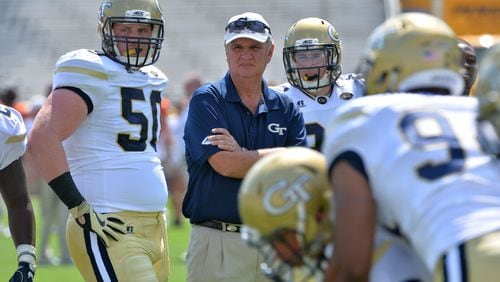As they prepare for their June arrival at Georgia Tech, the members of the Yellow Jackets’ 2017 freshman class have continued the connection they developed during their recruitment. They interact often through group messages on social media.
“We have one everywhere,” said Zach Quinney, an all-state offensive tackle from Savannah Christian. “We have one on Twitter. Messages on Snapchat. Just all over the place.”
One message that is recurring: Be ready to go.
“Just making sure we keep each other accountable,” Quinney said. “We all just kind of say, ‘If there’s a chance we can play this year, we’ve got to go ahead and push it.’”
The advice is particularly meaningful for Quinney. Jahaziel Lee and Andrew Marshall figure to be Tech’s starting left and right offensive tackles, respectively. Who will back them up next season is an uncertainty. It may well be Quinney or another incoming freshman such as Connor Hansen of Tallahassee, Fla.
Offensive tackle figured to be a position of strength for Tech when the regular season ended. Eason Fromayan (nine regular-season starts), Marshall (eight), Trey Klock (four starts) and Lee (three) were all expected to return, a foursome that could rotate and compete with one another. However, Fromayan decided to forego his senior season to pursue a career as a NASCAR pit-crew man. In January, Klock elected to leave Tech as a graduate transfer, landing at Northwestern.
“Obviously, at tackle, the loss of Eason and also with losing Klock, you have to go back and re-fill that thing,” offensive line coach Mike Sewak said. “If those two guys were still here, you’d have a little bit more depth.”
A lack of offensive-tackle depth isn’t quite a topic that will set Twitter on fire, and it’s a preferable concern to a lack of starters, but it has Sewak’s full attention. He prefers to play a three-man rotation and recognizes that getting through a season without injuries there (or elsewhere on the line) is not the norm. In the past five seasons, Tech has started four different players at tackle four times and five players once.
In spring practice, Jake Stickler and Bailey Ivemeyer are playing tackle on the second-string offense. Stickler is a junior who played eight games last season, mostly on special teams. Ivemeyer, a sophomore walk-on, got into one game last season and was named the offensive scout-team player of the year. (Ivemeyer’s father, John, started at left tackle for the Jackets in the 1983 and ’84 seasons.)
Add this into the mix: Lee’s performance this spring has underwhelmed coach Paul Johnson and, in the event of an injury to center Kenny Cooper, it’s possible that Marshall would be moved there from tackle, as No. 2 center Scott Morgan did not play in a game last season.
Not surprisingly, Sewak has been checking up on Quinney to make sure he’s keeping up with the workout plan provided by Tech’s strength-and-conditioning staff and communicating the urgent need for help at tackle.
Quinney, 6-foot-5 and 265 pounds, became quite aware as Fromayan and Klock made their decisions.
“Honestly, it made me want to work a little bit harder, just knowing that there’s that much more of a chance that I could get playing time this year,” he said.
In most years, it would seem a long shot that Quinney could help this fall. Before last season, only three offensive linemen had played as freshmen in Johnson’s tenure. But last season, all three of Tech’s freshman linemen — guard Parker Braun, Cooper and Lee — not only played, but started.
Quinney is one of five signees on the line. Charlie Clark (Marist School), Mikey Minihan (Honolulu), Boe Tufele (Harbor City, Calif.) and Hansen are the others.
“Maybe we won’t be as fortunate this year, or maybe we’ll be just as lucky,” Sewak said. “I think we have good athletes coming in. I think that there’s opportunity for them to do something, too. I think there’s some guys here in the program that have got to step up to make sure that, hey, look, I’m not going to get bypassed by another class.”
Quinney is trying to give himself a shot. He has been working out at least six days a week, he said, running and lifting. It could help his adjustment, too, that Savannah Christian ran many of the same plays that Tech does. During his official visit in January, he said, co-line coach Ron West and Sewak introduced the playbook to him, and Quinney realized that many were exactly the same as what he had run in high school.
“If you can play, you can play,” Johnson said. “Sometimes you play because you’re the better player. Sometimes you play out of necessity. It is what it is.”
About the Author







